People-batteries: a theoretical analysis of nanogenerators based on triboelectric effect

One of the most pressing problems of our time is energy, or rather its lack. The natural resources of the earth are depleted as the population grows. Therefore, people turned to renewable energy sources, the use of which will be able to resolve the inevitable energy crisis. Geothermal, solar, hydropower - all these are sources of renewable, almost limitless (on the scale of human life) energy. But there is another source that science fiction writers are more relevant than scientists. This is the man himself. But no one is going to connect a bunch of wires to a person’s body and shove it into jelly capsules. The theory, which will be discussed today, is based on the exploitation of the triboelectric effect, which will allow a person to become a source of energy for wearable devices (watches, telephones, etc.). Let's try to understand the essence of this study. Go.
Theoretical basis
')
As already mentioned, just a few lines ago, the basis of this theoretical study is the triboelectric effect * .
Triboelectric effect * is, in simple words, the occurrence of electric charges due to friction.The existence of this physical phenomenon was known in the times of ancient Greece. Thales Milesky is the author of the observation of triboelectricity by rubbing amber with wool, due to which the former received the ability to attract small objects (hair, paper, etc.). Subsequently, it was the Greek version of the word "amber" (ἤλεκτρον - ēlektron) and served as the basis for the word "electricity". However, in those days, they knew little about electricity, its types and properties. Many centuries have passed until the process of systematic study of this phenomenon has begun.

Postage stamp (1994, Greece) with the image of Thales of Miletus and amber, attracting a feather due to the triboelectric effect.
How does the triboelectric effect manifest in practice? Everything is extremely simple. If we rub two objects together, we will get static electricity due to this very effect. Everything that surrounds us consists of atoms, in the center of which there is a positively charged nucleus surrounded by electrons. Due to the interatomic interaction, if at one object the attraction of atoms is more powerful, then the electrons of the second begin to move towards the first. Thus, one object acquires electrons, and the other loses them, which is the occurrence of static charges.
This video explains the principle of triboelectric effect quite lucidly, and also shows the experience that you can repeat at home.
Naturally, not all materials are the same. Some better accumulate a positive charge, others - negative. Therefore, materials that are prone to manifestation of the triboelectric effect are placed in the so-called triboelectric series (from positive to negative).
But the triboelectric effect is only part of the study. In addition to it, nanogenerators play an important role - devices capable of converting mechanical or thermal energy into electricity. Tribo-effect nanogenerator (TENG) is not as old as the experience with Thales amber, and was first demonstrated in 2012.
Collecting energy with the help of this miracle device is a very promising industry, therefore, many research groups are developing new ways to implement this technique. Just imagine: you are walking around the city, and your phone is charging due to your movement. It sounds very cool, but there are a number of problems that have not yet been sorted out, so we don’t see various nanogenerators for every taste on the shelves of electronics stores.
The basis of the study
The main objective of the study was to identify the properties and characteristics of nanogenerators based on the triboelectric effect, as well as the theoretical justification of the problems of implementing such a technology.

TENG scheme.
Researchers point out that at least one non-conductive triboelectric surface is present in TENG, which is why its internal impedance (impedance) is quite high. And when moving the triboelectric layers, it can increase even more. As a result, it is possible to effectively extract the required power from the TENG through an external load only in the case of high load resistance.
The vast majority of devices do not meet these requirements, which is why an impressive proportion of potentially useful power will be lost due to the impedance mismatch.
Scientists say that understanding the characteristics of energy conversion and power transfer based on changes in impedance is the basis for improving TENG devices.
Experimental setup architecture
There are several mechanisms of operation of nanogenerators. In this study, a vertical contact separation model was used.
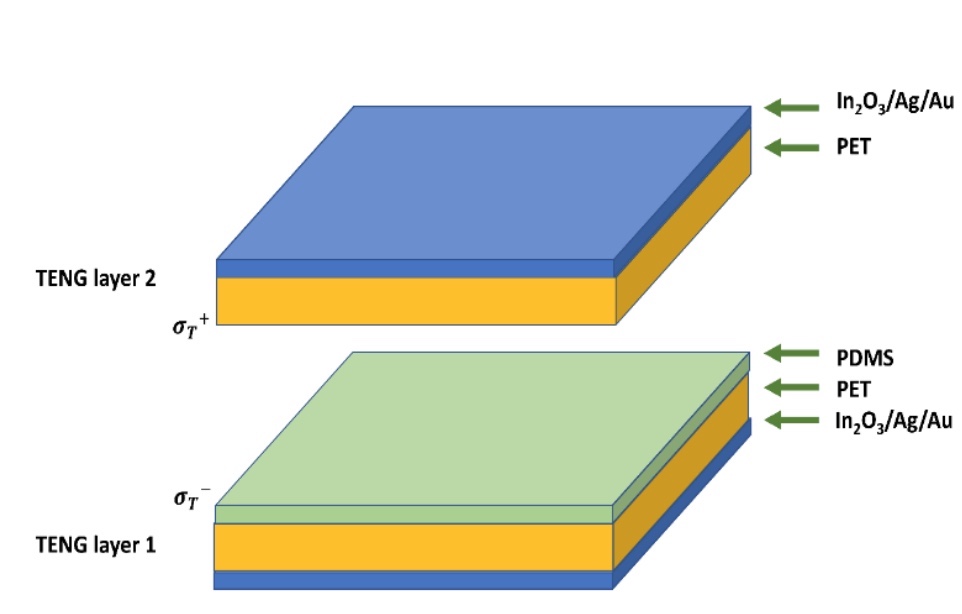
Scheme of triboelectric layers.
In the diagram above, we see 2 TENG layers with positive and negative charges. Each layer consists of several components: a base of In 2 O 3 / Ag / Au (blue sublayer), PET - polyethylene terephthalate (orange sublayer) and PDMS (PDMS) - polydimethylsiloxane (green sublayer). The size of the layers was 50 x 50 mm, and the thickness was 0.22 mm of the first and 0.2 mm of the second layer.
The triboelectric charge density was 40.7 µC / m -2 (µC - microcollon). And the dielectric constant was: 3.24ε 0 for the first layer and 3.3ε 0 for the second, where ε 0 is the dielectric constant of empty space.
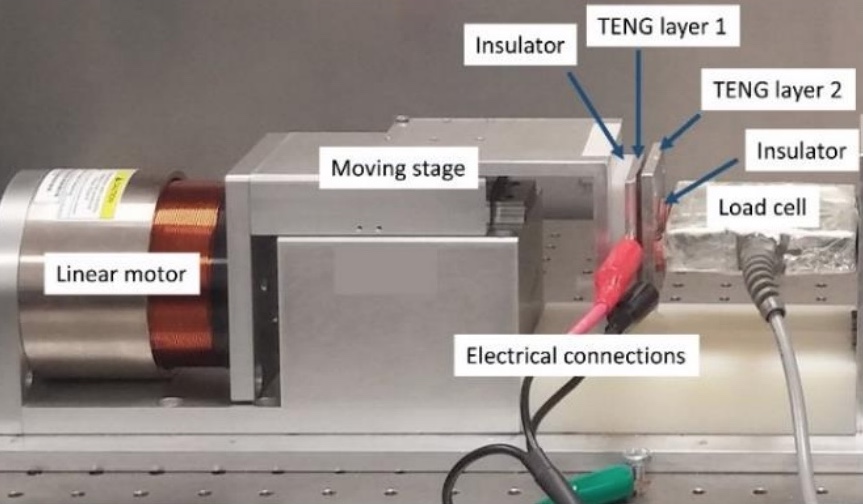
The appearance of the experimental setup.
The installation shown in the picture above consists of a linear motor, a moving base, insulators, two TENG-layers, a load sensor and electrical connections.
This installation was located in a room with a temperature of 20˚C and a relative humidity of 55% (the lower the humidity, the better the charge transfer occurs, as stated in the video). The motor allowed the layers to come into contact with a certain periodicity. The more such contacts (friction), the higher the charge density indicator. A total of 3000 contact layers were produced in this experiment.
Results analysis
After the experiments, the scientists collected all the data and, after analyzing them, categorized a number of factors affecting the operation of TENG devices:
- Movement: frequency, amplitude and contact / non-contact modes of motion;
- Device: material properties and dimensions of TENG-device.
And now a little more about each.
Frequency
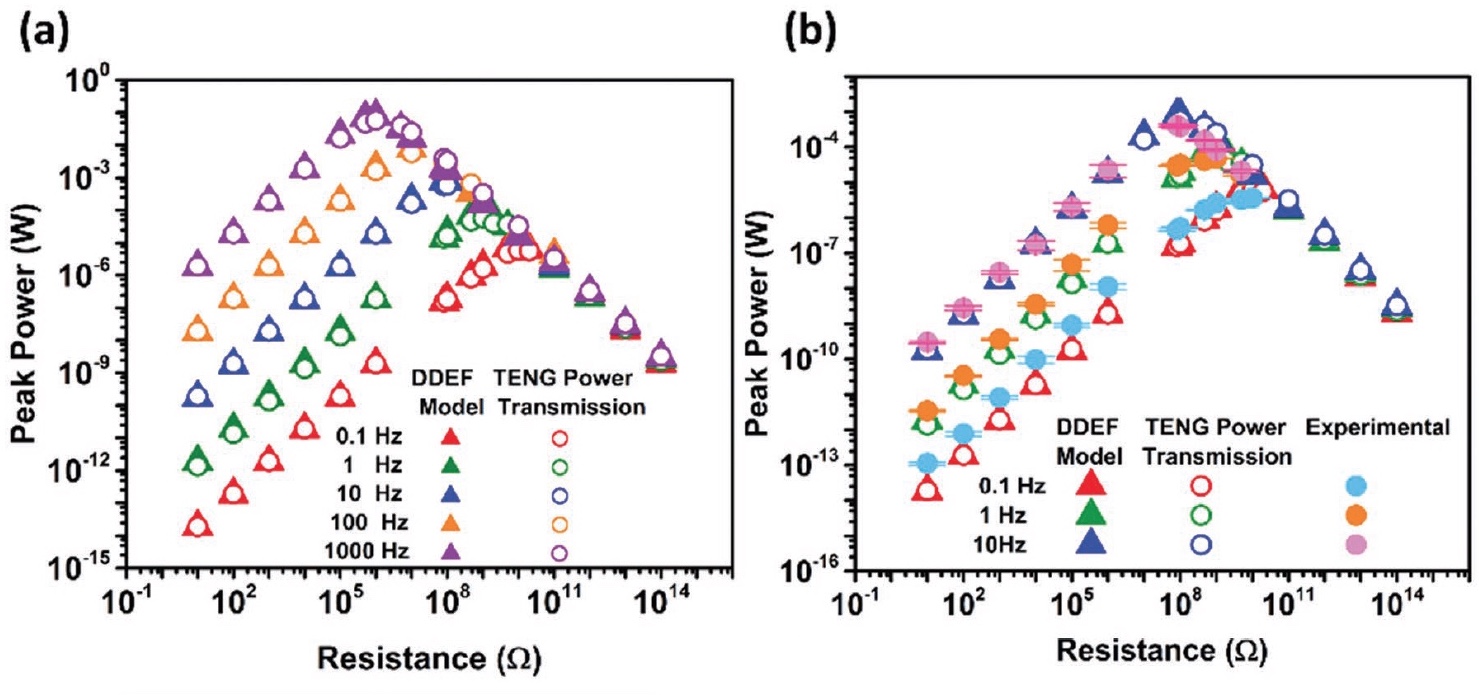
The graph above ( a ) is a comparison of the peak power parameters of the theoretical model DDEF (distance-dependent electric field) and the theory of TENG layers at different frequencies (from 0.1 Hz to 1000 Hz). In turn, graph ( b ) shows a comparison of data from the DDEF model, the theory of TENG layers plus experimental data obtained experimentally at a frequency of 0.1 Hz to 10 Hz.
It is clearly seen that with increasing frequency, the output power also increases. However, the real frequency in practice is limited by human physiology (in other words, we cannot move like the Tasmanian devil from Looney Tunes). However, the researchers are not upset, as there is a way to convert low frequencies to higher ones. For example, a mechanical regulator consisting of a coil spring, gears, cam mechanism and flywheel. This simple, given the details listed, the device is capable of delivering a frequency of 50 Hz. (Researchers cite Divij Bhatia's work, available for download at the link ).
It turns out that there are ways, simple and effective, to increase the frequency, and hence the output power. However, it is worth noting that the frequency also cannot be greater than a certain level (10 GHz), which is associated with dielectric losses arising at high frequencies.
Amplitude
In order to check how the amplitude of the movements affects the output power, the frequency level was set to 1 Hz, as a constant, so that this parameter would not affect the measurement of the influence of amplitude only.

Above are two graphs: theoretical results and experimental. The tendency at the beginning is similar with increasing frequency, that is, the output power increases with increasing amplitude. However, when a certain level is reached (1 mm), it begins to decrease. Thus, the amplitude of movement is a very unstable factor. More precisely, this is a parameter with a narrow range, because if the amplitude is too low or too high, we will not get the desired result. Scientists intend to further examine in more detail the effect of amplitude on the output power generation, and also find ways to optimize this factor.
Contact / contactless driving modes
Triboelectric layers must touch each other during motion cycles, right? Nearly. Some devices operate in a contactless mode when they are fully charged. Thus, it is necessary to check how the distance between the layers affects the result of the work of the TENG device. During the test, the frequency was 1 Hz, and the amplitude was 1 mm, again, constants, so as not to interfere with the verification of the required parameter.

And again we see two graphs (theory and experiment). It is logical that the increase in the gap between the layers of the output power begins to fall. The values fell from ≈430 to ≈150 nA (nanoampere), when the gap reached 500 microns. At the same time, the resistance increased from 1 GΩ (gig) with a break of 0 to 5 GΩ when breaking at 500 μm.
And again, the harsh reality does not allow scientists to build cloud castles. The conclusion is simple - the distance between the working TENG layers is a critical parameter. More precisely, the lack of air gaps between them. It is clear that in the process of separation the layers "diverge", so to speak, but there should be no air between them. This problem can be solved, for example, by using polymers in the TENG architecture, such as polydimethylsiloxane.
In conclusion, it can be noted that the amplitude and frequency must be no higher than the limit level, as well as the distance between the layers, in order for the system to work efficiently. These are pretty strong limitations, in fact. However, many research groups, including this one, are working to reduce the impact of these parameters on the performance of TENG devices.
We now turn to the consideration of what the devices themselves should be in order to fully take advantage of all the advantages of TENG technology. For an important role in the operation of any device is played not only by physical phenomena, but also from what and how the device is made. As they say, no matter how hard you throw a papier-mâché spear, it will not fly farther than a normal spear.
Material properties
Let us remind ourselves that the triboelectric charge density directly depends on several factors: the triboelectric series (the farther from each other the substances, the better they interact, this is mentioned in the video above), the structuring of the triboelectric surfaces, the contact area under the influence of the applied force and environmental factors .
To check what and how it influences, the DDEF model was used during sinusoidal motion (frequency = 1 Hz, amplitude = 1 mm), and the parameters of the device coincide with those in the practical experiment.
Data analysis shows that the output power rate increases with increasing charge density. In this case, the internal impedance does not change when the charge density changes.
But changes in parameters in the environment, such as humidity, temperature and pressure, of course, affect the charge density, making this indicator unstable. If the device operates in a controlled environment, then it is possible to maintain the stability of this indicator. Of course, this is very sad, since in practice we will not use our devices only under certain conditions. Therefore, this moment was also sent by scientists for further refinement and research.
Scientists also note that this theoretical experiment shows vivid interrelationships, but in practice it is extremely difficult to implement, since changing a certain material parameter actually means replacing the material itself, which means changing all other properties.
Physical dimensions
When it comes to wearable devices, we understand that their component parts should be as small as possible (sorry for the pun). But there is a certain limit, a line, which we have crossed over sacrificing efficiency for the sake of small size.
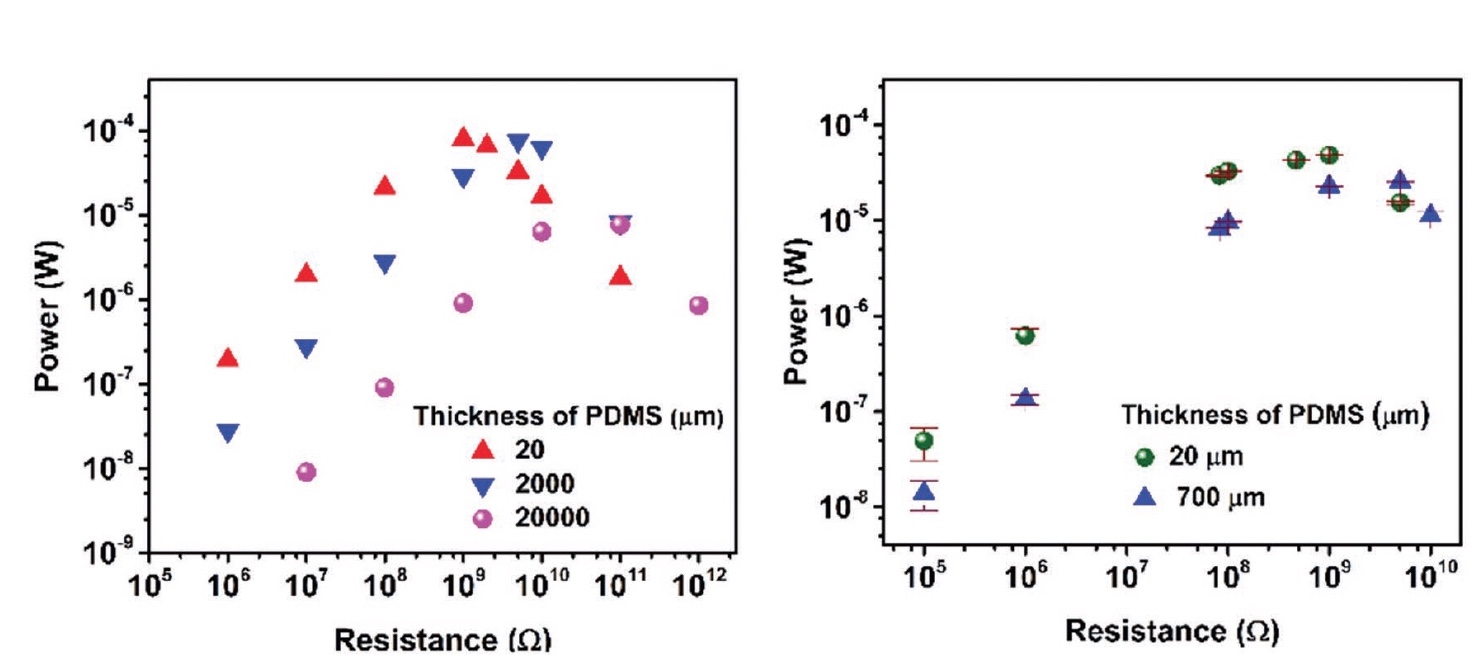
The two graphs above represent the results of measuring the output power when the thickness of the PDMS layer changes (the theory on the left and the experiment on the right). With increasing thickness PDMS output power decreases. This theoretical trend has been confirmed in practice, which can be seen if we compare both graphs.
The electric field with a charged surface of the TENG layer must extend to a greater distance when the thickness of the PDMS is greater in order to reach the electrode-dielectric interface, where the output charges are induced. This leads to a weakening of the electric field, which subsequently leads to a decrease in output power and an increase in impedance. So the principle “the more the better” is not applied here.
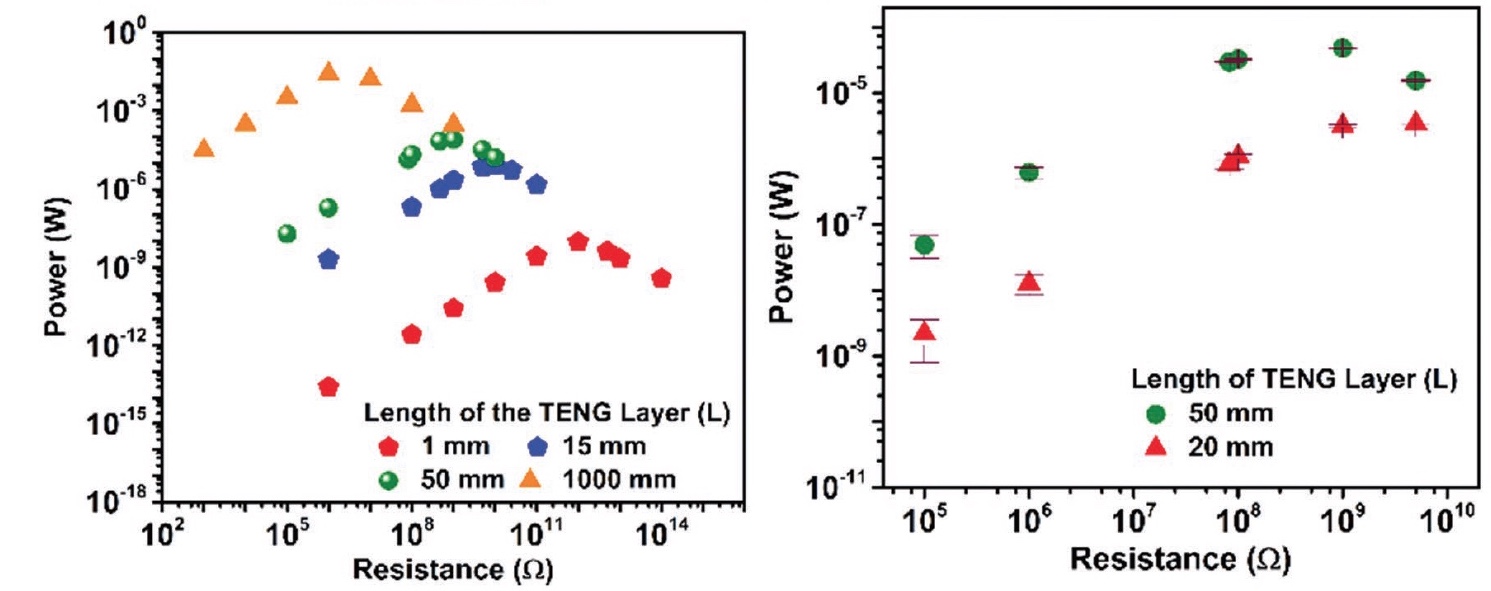
When changing the length of things are different. The output power increases with the elongation of the device, if we compare the figures above with a length of 50 mm and 1000 mm. This is good, because more area - more power. However, for compact devices, which TENG devices are basically aimed at charging, could hardly be called such if they were a meter in length.
Details of the study (theoretical models, formulas, calculations, etc.) can be found in the report of scientists and in additional continents to it.
Epilogue
This study was aimed at describing the characteristics, important factors of influence and features of triboelectric nanogenerators. The researchers themselves say that their work should help in the future development of TENG devices, as it clearly indicates the advantages and disadvantages of this technology. And as we can see, there is still a lot of work to be done so that we finally stop worrying that our wearable devices will discharge during the walk.
Energy has always been a value for humanity, regardless of its type. But if earlier we simply cleaned up what the planet gives us, now we need to look for ways to generate energy, which is enough for everyone. The only pity is that the fact that we have practically practically exhausted natural resources has become the impetus for the beginning of such searches. As someone said (I really don't remember who): Why not divide everything between everyone? But because there is little, but there are many. Hopefully, in terms of energy this will change, sooner or later.
Thank you for staying with us. Do you like our articles? Want to see more interesting materials? Support us by placing an order or recommending to friends, 30% discount for Habr users on a unique analogue of the entry-level servers that we invented for you: The whole truth about VPS (KVM) E5-2650 v4 (6 Cores) 10GB DDR4 240GB SSD 1Gbps from $ 20 or how to share the server? (Options are available with RAID1 and RAID10, up to 24 cores and up to 40GB DDR4).
VPS (KVM) E5-2650 v4 (6 Cores) 10GB DDR4 240GB SSD 1Gbps until December for free if you pay for a period of six months, you can order here .
Dell R730xd 2 times cheaper? Only we have 2 x Intel Dodeca-Core Xeon E5-2650v4 128GB DDR4 6x480GB SSD 1Gbps 100 TV from $ 249 in the Netherlands and the USA! Read about How to build an infrastructure building. class c using servers Dell R730xd E5-2650 v4 worth 9000 euros for a penny?
Source: https://habr.com/ru/post/425163/
All Articles